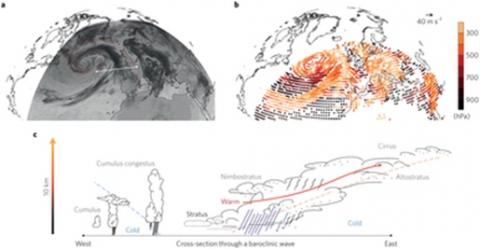[2015] Interactions between clouds, circulation and climate
Fundamental puzzles of climate science remain unsolved because of our limited understanding of how clouds, circulation and climate interact. One example is our inability to provide robust assessments of future global and regional climate changes. However, ongoing advances in our capacity to observe, simulate and conceptualize the climate system now make it possible to fill gaps in our knowledge. We argue that progress can be accelerated by focusing research on a handful of important scientific questions that have become tractable as a result of recent advances. We thus propose to increase our understanding of (1) the role of cloud feedbacks and convective organization in climate, and (2) the factors that control the position, the strength and the variability of the tropical rain belts and the extratropical storm tracks.
Although general circulation models constitute one of the pillars of climate science, shortcomings in their representation of clouds, precipitation and circulation have persisted for many generations of models. These shortcomings cause significant problems that remain even when other complexities in the system are stripped away. To gain the most from comprehensive modelling approaches requires energizing model development efforts around those processes that most affect the simulation of storm tracks, tropical rain belts and climate sensitivity. 4 questions have been identified:
- What role does convection play in cloud feedbacks?
- What controls the position, strength and variability of storm tracks?
- What controls the position, strength and variability of the tropical rain belts?
- What role does convective aggregation play in climate?
In the long run, such an approach will also advance the utility of global modelling more broadly, because questions such as the future of the permafrost layers, or the dynamics of the terrestrial and ocean carbon sinks, depend very much on the magnitude of warming and the distribution of precipitation.
In addition, the numerous scales and boundless diversity of processes that challenge the modelling also challenge observing systems. Better understanding will highlight gaps or weaknesses in these observing systems, and therefore will help prioritise the needs for new observations, imaginative field campaigns, or novel reconstructions, synthesis or interpretations of the long-term palaeoclimatic data records. Here again, developing a consensus around the pursuit of a few questions may disproportionately advance the field, for instance by better identifying the needs and opportunities for advancing the palaeo- or satellite records.
Reference: Bony, S., Stevens, B., Frierson, D.M.W., Jakob, C., Kageyama, M., Pincus, R., Shepherd, T.G., Sherwood, S.C., Siebesma, A.P., Sobel, A.H., et al. (2015). Clouds, circulation and climate sensitivity. Nat. Geosci. 8, 261–268.
Figure: What controls the position, strength and variability of storm tracks ? a- Infrared radiances visualize patterns of clouds in a developing storm whose wavelike structure is outlined by red contour delineating air-mass boundaries in the upper troposphere. B- cloud motion vectors, coloured by cloud-top pressure, derived from radiances. C; Conceptual cartoon illustrating major cloud type along a cross section through the storm system.

